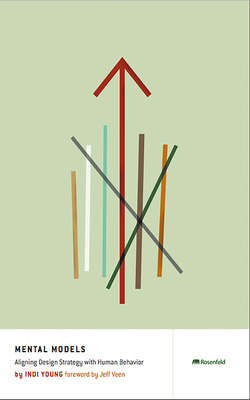Mental Models

Реклама. ООО «ЛитРес», ИНН: 7719571260.
Оглавление
Indi Young. Mental Models
Mental Models: Aligning Design Strategy with Human Behavior
How to Use this Book
Who Should Read this Book?
What’s in the Book?
What comes with the Book?
Here’s How You Can Use Mental Models
Frequently asked Questions. What is a mental model?
What if I don’t have a big budget?
What do you mean by “task?”
What are task-based audience segments?
How do I uncover the root task?
What do you mean by a content map’s “content”?
Does a content map show every detail of my solution?
How can analyzing gaps in a mental model show me innovative ideas?
How can mental models help me make sense of all my web properties?
Foreword
CHAPTER 1. What and Why? The Advantages of a Mental Model
What is a Mental Model?
Why Use Mental Models?
Confidence in Your Design
Clarity in Direction
Continuity of Strategy
CHAPTER 2. When? Using Mental Models with Your Other Work
Determine Your Research Method
How Mental Models Hook into Other UX Techniques
Shortcuts and Other Ways to Use Mental Models
CHAPTER 3. Who? Mental Model Team Participants
Project Leader
Project Practitioners
Project Guides
Project Support
CHAPTER 4. Define Task-Based Audience Segments
Task-Based Audience Segments
Set Research Scope
CHAPTER 5. Specify Recruiting Details
Estimate the Tally
Write the Screener
Coordinate Schedules
Recruit Participants
CHAPTER 6. Set Scope for the Interviews
Set Research Goals
List Interview Prompts
CHAPTER 7. Interview Participants
Chat by Telephone or Face-to-Face
Do Not Lead
Plan Your International Interviews
CHAPTER 8. Analyze the Transcripts
Comb for Tasks
Get Some Practice
Answers
CHAPTER 9. Look for Patterns
Group Tasks into Patterns
Plan Your Logistics
Congratulate Yourself
CHAPTER 10. Create the Mental Model
Build the Model Automatically
Build the Model Block-by-Block
Review the Diagram with Project Guides
What Did You Learn?
Decorate the Diagram
Ask for Feedback
CHAPTER 11. Adjust the Audience Segments
Compare Results to Original Hypothesis
Clarify Segment Names
Adjust Segment Definitions
Use Audience Segments for Other Projects
Transition from Research to Design, Verbs to Nouns
CHAPTER 12. Alignment and Gap Analysis
Draw a Content Map of Your Proposed Solution
Align the Content Under the Mental Model
Consider the Opportunities
Share the Findings
Print the Diagram
Prioritize the Opportunities
CHAPTER 13. Structure Derivation
Derive High-Level Architecture
Provide Vocabulary for Labels
Test Your Structure and Labels
Generate Features and Functionality
Acknowledgments
About the Author
Отрывок из книги
Necessity is the mother of invention. Historically, tool design—from a sharpened stone ax to a folding Japanese pruning saw—has been inspired by need. The designers themselves range from seemingly isolated genius inventors to cubicle farms of engineers with explicit specification documents. Really successful design—that which solves the problem, is easy to use, and is beautiful to behold while functioning—is hit and miss. Innovation is elusive. Lots of money and hope are put towards products that look encouraging at the outset, but end up not quite reaching the mark. Entrepreneurs, investors, designers, engineers, and customers all get burned more often than they succeed.
There is no one method to follow to create perfect products. But there are many ways to increase the odds. One of them is to understand the reason for the tool in the first place. Deeply investigate what people are trying to get done and line up your solutions to match. Are you trying to solve a small part of a larger puzzle that could be simplified if you look at a broader context of the customer’s behavior and philosophies? Do you have so many aspects to your service that it’s hard to prioritize where to invest more development dollars?
.....
Five-Year Plan
Figure 1.3. http://flickr.com/photos/rosenfeldmedia/2158700329
.....